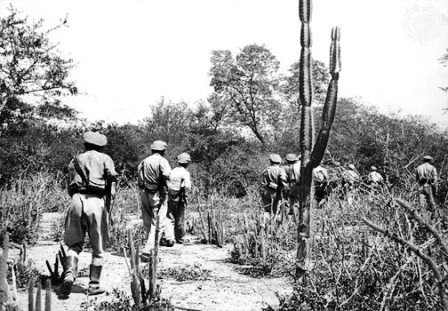|
The Chaco War: Bolivia vs. Paraguay Just prior to the Chaco War, neither
Bolivia
nor Paraguay was particularly interested in inhabiting or developing the region because of the lack of water, its harsh
climate
and the inhospitable nature of the land. Paraguay did produce a traditional tea called "máte", most of which was sold to Argentina, so it had enough economic importance to Paraguay for Paraguay to want to own the region and defend itself against Bolivia.
In Bolivia, most economic activities were taking place in the Western Andes region and Bolivians were initially apathetic about defending the Chaco region because it had very little economic value and even less population. Both countries are landlocked and neither has access to the sea, so control of the Paraguay River was important to each as it provided a waterway necessary for trade, exports and transportation. It was also believed that oil and gas existed in the region. (Photo:britannica.com) When Bolivia began to take more seriously the advantages of the Paraguay River and the possibility that oil could be exploited in the Chaco Region in the early 1900’s, it began to build forts along the border. Paraguay then did the same and small armed confrontations began to take place along the border between the two countries although most were fought by natives (such as the Guaraní and Izocenos) forced by the government to join the army. By 1932, Paraguay sent massive numbers of troops to the border. On June 15, 1932 a Bolivian force raided a Paraguayan fort in Vanguardia and this touched off the Chaco War. Who held the advantage at any given moment during the war depended greatly on the terrain in each area and town in which battles were taking place. The Bolivian army was initially larger and better trained than the Paraguayan army. Some say that, being from the highlands, Bolivia soldiers could not weather the harsh climate and conditions of the hot, arid Chaco savannahs. However, at other times, Bolivia temporarily held the advantage, such as in Charagua, where it is said the Paraguayan soldiers were at a disadvantage because they were unaccustomed to fighting in the hills. https://youtu.be/jfWFr671nJo The war lasted almost exactly three years, during which time over 50,000 Bolivians and 35,000 Paraguayans lost their lives. Thousands died because they could not survive in the harsh climate. Many were overcome by diseases such as malaria and other infections (it is said more soldiers died of disease than from war wounds). The Paraguayan army was able to force the Bolivians to retreat past the half-way point of the territory under dispute. After many battles the war ended on June 12, 1935 with the defeat of Bolivia and the signing of a truce. In 1938 three quarters of the territory fought for was officially given over to Paraguayan control and Bolivia was left with the northernmost quarter of the Gran Chaco.
    |
